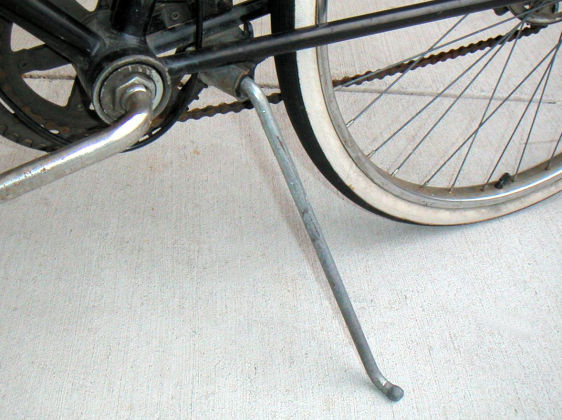
|

![]()
Should your bicycle have a kickstand? Maybe yes, maybe no. It depends on the type of riding you do, your preferences, and your bicycle.
A kickstand is convenient when opening a garage door, or when parking the bicycle in a secure space, or for a tour guide or instructor who has to step off the bicycle. Without a kickstand, you have to lay the bicycle down, or lean it against a pole, a tree, a wall, a car. Still, unless you can lock a brake, the bicycle can roll away and fall over. Or you could back the bicycle up alongside a curb so a pedal rests on it. The bicycle must be level or facing slightly uphill. This is not super stable. In France, curb parking prevailed even among utility riders, at least through the 1980s.
A kickstand which will |
A French crank does double duty
|
|---|
If the bicycle is rolled backward, the crank will jam against a kickstand mounted behind the bottom bracket. The crank has a lot of leverage. It will loosen the kickstand and damage the frame, unless there is a special plate for the kickstand to bolt to, or the kickstand pivot is integral with the frame as in the image below..

Photo by Andrew Dressel, Gnu Free Documentation License, cropped.
Racers and other cyclists who care about performance avoid kickstands because they add weight to a bicycle. The bicycle must be on a level, firm surface for a kickstand to hold it steady. A load mounted high on the rear rack tends to destabilize the bicycle so it will fall toward the left side. Rear pannier bags can interfere with a kickstand., A rubber foot is desirable to protect floors but not always included. But really, the most important drawback to a kickstand is the likelihood of frame damage.
![]()
![]()
There are three common types of kickstands.
A. side kickstand mounts on the left side of the bicycle either just behind the bottom bracket, like the ones shown above, or near the rear hub, as shown below, avoiding interference with the crank. The bicycle leans to the left. The front wheel turns to the left, due to the bicycle's front-end geometry. Bicycles parked tightly together take up more space if standing on side kickstands than if held upright by a bike rack.
Photo by Andrew Dressel, Gnu Free Documentation License, cropped.
A center stand -- usually a two-leg kickstand -- holds the bicycle upright and lifts one wheel slightly off the ground. The front wheel can face straight ahead. A baggage load does not tend to unbalance the bicycle, as long as it is evenly distributed on either side. Most center stands mount just behind the bottom bracket. A two-leg center stand is usually a single hinged piece, but the video below shows two-leg center stand both of whose legs cleverly fold to the left side.
![]()
![]()
Kickstands are traditionally designed for steel bicycle frames. Different frames work with different kickstands, but kickstands are not compatible with many frames, particularly carbon-fiber frames. You do best to take the bicycle to a shop rather than ordering blindly over the Internet.
The leg(s) of a kickstand must often be shortened during installation. Length is quite critical. Some kickstands are adjustable, others not. Bicycle wheel size makes a major difference with a kickstand that mounts near the rear hub. So, check for compatibility. Unless you are good to cut off a tiny bit at a time, ask the bike shop to install the kickstand.
![]()
![]()
Last Updated: by John Allen